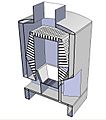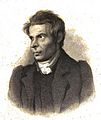Heating facts for kids
Heating is the process of making something warmer. It means adding heat energy to an object or a space. We use heating to keep our homes cozy, warm our food, or even help machines work better.
Sometimes, heating is part of a bigger system called HVAC. This stands for Heating, Ventilation, and Air-Conditioning. HVAC systems control the temperature, air flow, and air quality inside buildings. The "R" in HVACR stands for Refrigeration, which is about making things cold.
How We Heat Things
People have found many ways to create heat. From ancient fires to modern electric systems, the goal is always to make our lives more comfortable.
Common Heating Devices
Many different devices are used to produce heat. Here are some common ones:
- Boiler: A boiler heats water or steam. This hot water or steam then travels through pipes to warm up different parts of a building. Boilers are often part of a central heating system.
- Central Heating: This is a system that warms an entire building from one main point. Heat is sent to many rooms using hot water, steam, or warm air. It's a very common way to heat homes and offices.
- Convector Heater: This type of heater works by warming the air around it. The warm air then rises, and cooler air sinks to be heated. This creates a flow of warm air that spreads through the room.
- Fan Heater: A fan heater uses a fan to blow air over a hot heating element. This quickly pushes warm air into a room, making it feel warmer fast.
- Fireplace: A fireplace is a special space built into a wall. It is designed to safely hold a fire, which provides heat and can also be used for cooking. Fireplaces often use wood as fuel.
- Gas Heater: These heaters burn natural gas or liquid petroleum gas (LPG) to create heat. They are a popular choice for heating homes in many areas.
- Heating Pad: A heating pad is a soft pad that warms up. People use them to apply gentle heat to parts of their body, often to soothe muscles or for comfort.
- Radiator: A radiator is a device that transfers heat from hot water or steam into a room. It's usually a metal panel with fins that help spread the heat. Radiators are a key part of many central heating systems.
- Solar Heating: This method uses energy from the sun to create heat. Solar panels can collect sunlight and use it to warm water for showers or to heat spaces in a building. It's a way to use clean, renewable energy.
- Storage Heater: An electric storage heater warms up during times when electricity is cheaper, usually at night. It then slowly releases this stored heat throughout the day.
- Water Heating: This is simply the process of warming water. We use hot water for many things, like bathing, washing dishes, and in many industrial processes.
Other Ways to Heat
- Block Heater: This is an electric heater that warms a car's engine. It helps the engine start more easily in very cold weather.
- District Heating: This is a large system that provides heat to many buildings from one central power plant. It's like central heating, but on a much bigger scale for a whole neighborhood or city.
- Geothermal Heating: This method uses the natural heat from deep inside the Earth. Geothermal heat pumps can bring this heat to the surface to warm buildings.
- Induction Heating: This process heats metal objects using electromagnetic fields. It's often used in factories for melting metals or in some modern stovetops for cooking.
- Radiant Heating: This system heats a building by sending out radiant heat, like the warmth you feel from the sun. It warms objects and people directly, rather than just heating the air. This can be done with heated floors or panels.
Images for kids
-
Ruins of the hypocaust under the floor of a Roman villa at La Olmeda, Province of Palencia (Castile and León, Spain). This was an early form of underfloor heating.
-
The Summer Palace in St. Petersburg had an early system of hydrologic central heating, using water to spread heat.
See also
 In Spanish: Calor para niños
In Spanish: Calor para niños











